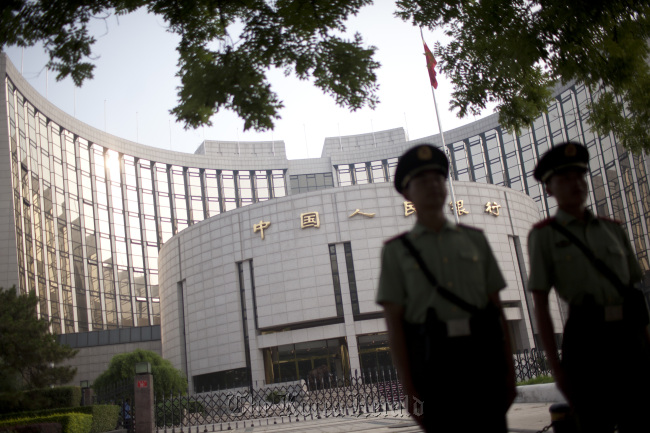 |
Paramilitary police stand outside the People’s Bank of China in Beijing. (Bloomberg) |
China cut borrowing costs for the first time since 2008 and loosened controls on banks’ lending and deposit rates, stepping up efforts to combat a deepening slowdown as Europe’s debt crisis threatens global growth.
The one-year lending rate declines by a quarter percentage point to 6.31 percent, the People’s Bank of China said in a statement Thursday. The one-year deposit rate drops the same amount, to 3.25 percent. The extra leeway banks will get to determine rates at variance from the official setting was called a “milestone” by UBS AG.
The move, before China reports inflation, investment and output figures Saturday, may signal that the economy is weaker than the government anticipated. Policy makers across the globe are also girding for a deeper impact from Europe’s woes, with Australia and Brazil also lowering rates in the past eight days. In South Korea, a pause in raising the benchmark has lasted a year, with the central bank staying on hold Friday.
“This will be the beginning of a rate cut cycle and there will be at least one more reduction this year,” said Shen Jianguang, a Hong Kong-based economist with Mizuho Securities Asia Ltd. who has worked for the European Central Bank. “The data to be released over the weekend must be very weak and inflation must have eased sharply.” (Bloomberg)
Asian stocks fell, paring their biggest weekly gain since February, after U.S. Federal Reserve Chairman Ben S. Bernanke said the Fed will need to assess conditions before deciding if more measures are needed to support growth. The MSCI Asia Pacific Index lost 0.7 percent at 10:24 a.m. in Tokyo.
Banks can offer a 20 percent discount to the key lending rate, up from a previous 10 percent, China’s central bank said Thrusday. Lenders will for the first time be able to offer savers deposit rates that are up to 10 percent higher than the benchmark.
The deposit-ceiling move is “unprecedented” and a “milestone for interest-rate liberalization,” said Wang Tao, chief China economist at UBS in Hong Kong, who previously worked at the International Monetary Fund.
U.S. Treasury Secretary Timothy F. Geithner has pressed China on the limit, calling as recently as April 26 for an increase to give savers higher returns and stoke consumer spending. The practice of keeping the deposit rate below the pace of inflation had forced households to “save excessively,” he said in a speech in San Francisco. (Bloomberg)
Weaker Lending
In China, the rate move signals policy makers’ concern at weakness in demand for loans. Three bank officials told Bloomberg News last month that the nation’s biggest lenders may fall short of loan targets for the first time in at least seven years as demand for credit wanes.
The central bank last reduced interest rates in late 2008, when the government unveiled a 4 trillion yuan ($586 billion at the time) stimulus package. Now, Chinese officials are monitoring the threat to exports from Europe’s crisis as Greece prepares for an election on June 17 that may determine whether it remains in the euro region. A crackdown on property speculation is also cooling the world’s second-biggest economy.
The yuan is down about 1 percent against the dollar this year, closing at 6.3635 Thursday.
In Wenzhou, an eastern Chinese city known as a center of entrepreneurship, “smaller businesses are in a much more dire situation now than during the financial crisis,” Zhou Dewen, head of the small and medium enterprise association, said in an interview in his office this week.
Pace of Change
Loosening restrictions on interest rates shows that the economic slowdown and the turbulence of Bo Xilai’s ouster from the Communist Party leadership aren’t derailing policymaking or efforts to reshape the financial system. The central bank has widened the yuan’s trading band, while Premier Wen Jiabao has called for the “monopoly” of big lenders to be broken.
The government may be “getting ready to step up its pace of financial reforms,” HSBC Holdings Plc said in a note. Policy makers regret “that the 2008 financial crisis was not used to introduce more reforms, so this time they want to take advantage of the window,” said Chen Zhiwu, a finance professor at the New Haven, Connecticut-based Yale School of Management.
Australia’s central bank cut interest rates this week, citing Europe’s crisis and moderating growth in China. The European Central Bank held its key rate at a record low, with President Mario Draghi saying that officials stand ready to act. The Bank of England kept its benchmark at a record low, while refraining from expanding a stimulus program.
(Bloomberg)








